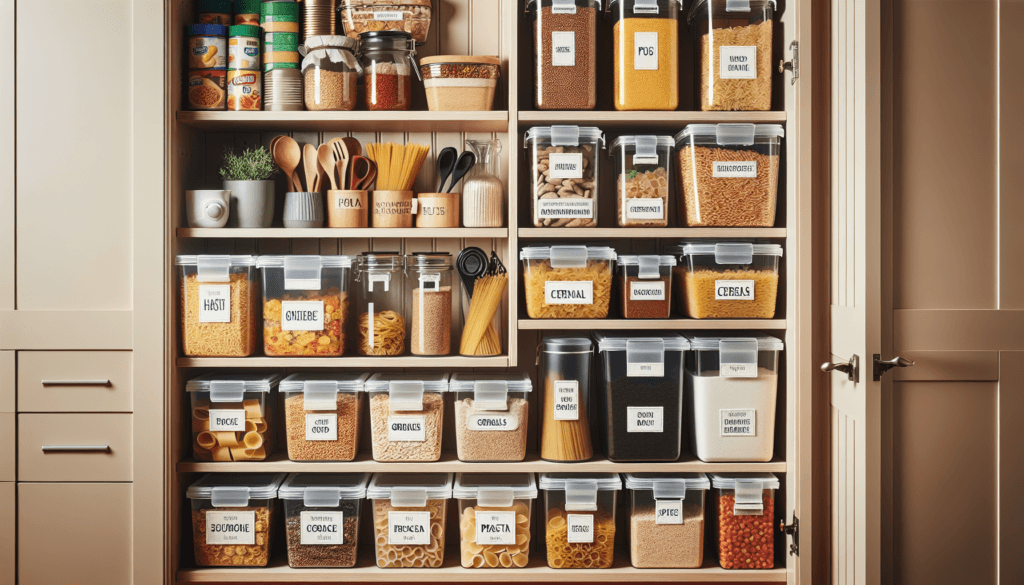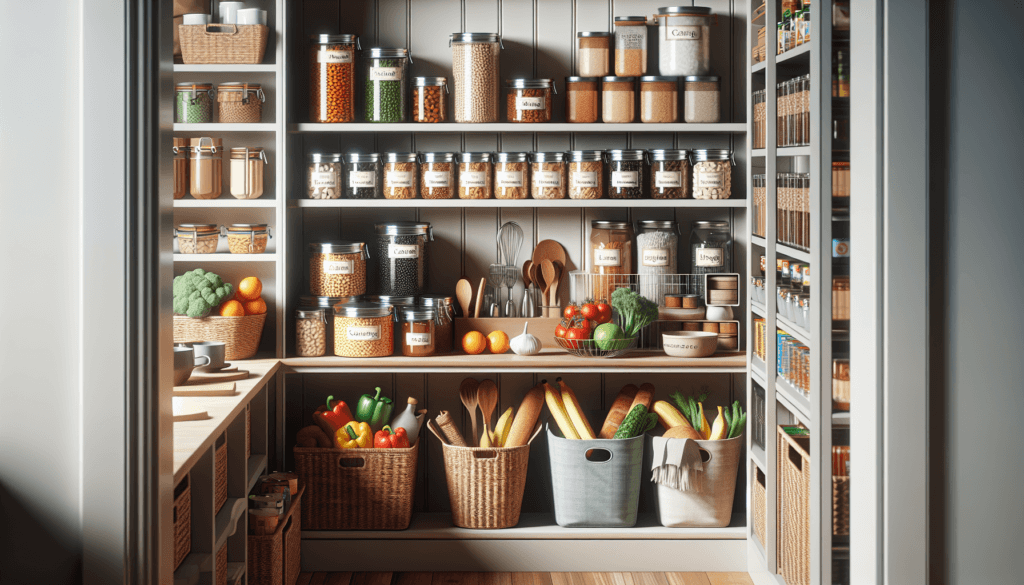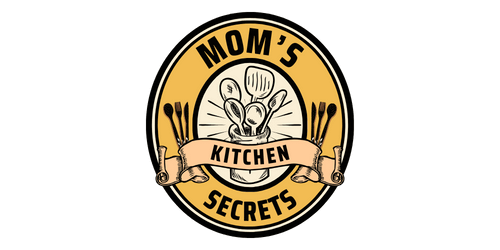Are you tired of rummaging through your pantry every time you need to find a specific ingredient? Look no further! This article will provide you with the best ways to organize your pantry, ensuring that everything is easily accessible and neatly arranged. From categorizing items to using clever storage solutions, you’ll discover simple yet effective tips to transform your pantry into an organized haven. Say goodbye to the chaos and hello to an efficiently arranged pantry that will make cooking and meal planning a breeze.
Categories for Organization
Food Groups
Organizing your pantry by food groups is a great way to easily locate ingredients when you need them. Grouping items like grains, canned goods, snacks, and beverages together can help streamline your cooking process and ensure that you always have the right ingredients on hand.
Meal Components
Separating your pantry items into meal components can be a game-changer. Create sections for pasta, rice, beans, and sauces so that you can quickly grab everything you need to make a complete meal. This organization method not only saves time but also promotes better meal planning.
Special Diets
If you follow a specific diet such as gluten-free, vegan, or keto, dedicating a section of your pantry for these special dietary needs can be extremely helpful. Keep gluten-free flours, plant-based protein bars, or low-carb snacks in their own designated space. This will make it easier for you to find suitable options and maintain your dietary goals.
Snack Items
Snacks are an essential part of any pantry. Designating a specific area for snacks, whether they are sweet or savory, allows you to easily grab a quick bite. Consider organizing them by type, such as chips, cookies, or granola bars, to satisfy your cravings without rummaging through the entire pantry.
Baking Supplies
If you enjoy baking, having a dedicated section for your baking supplies is essential. Keep your flours, sugars, baking powder, and baking soda together. This way, you can quickly find what you need when you feel the urge to whip up a batch of cookies or a delicious cake.
Canned Goods
Canned goods are a pantry staple that often takes up a significant amount of space. Organizing your canned goods will help prevent them from cluttering your shelves and make it easier to find what you need at a glance. Arrange them by type (e.g., vegetables, soups, fruits) and stack them neatly for optimal storage.
Condiments and Sauces
From ketchup to soy sauce, condiments and sauces can quickly accumulate and create chaos in your pantry. Keep these items together and consider using a storage bin or organizer to prevent them from falling over and making a mess. This way, you won’t have to scramble to locate your favorite hot sauce in the midst of cooking.
Spices and Seasonings
Spices and seasonings are the secret ingredients that add flavor to your dishes. Designate a small section or rack for your collection. Organize them alphabetically or by flavor profiles to easily find the right spice for your recipe. Consider using spice jars or magnetic spice containers to maximize space and keep them neatly arranged.
Beverages
Organizing your beverages can vary depending on the space you have available. Keep the most frequently consumed drinks at eye level and arrange the rest accordingly. Utilize stacking shelves or wire baskets to create additional storage space. By keeping your beverages organized, you won’t waste time searching for your favorite drink when you’re thirsty.
Kitchen Tools and Equipment
Your pantry is not just for food items. Consider dedicating a small section to store your kitchen tools and equipment. Keep items like baking sheets, measuring cups, and small appliances neatly arranged and easily accessible. This way, you’ll have everything you need within reach when you’re ready to cook or bake.
Clearing and Cleaning the Pantry
Removing expired items
Before organizing your pantry, it’s crucial to remove any expired or spoiled items. Check expiration dates and discard anything past its prime. This helps prevent clutter and ensures that you’re only working with fresh ingredients moving forward.
Wiping down shelves
Once you’ve emptied your pantry, it’s a good idea to wipe down the shelves to remove any dust or spills. Use a damp cloth or sponge and a mild cleaning agent to clean the surfaces thoroughly. This step not only keeps your pantry looking fresh but also helps maintain the cleanliness of your food storage area.
Using storage bins or baskets
Storage bins or baskets are fantastic tools for keeping your pantry organized. Use them to group similar items together, such as snacks or baking supplies. Not only do they create a clean and uniform look, but they also make it easier to find what you need without rummaging through the shelves.
Labeling containers
Labeling your containers is a simple yet effective way to maintain pantry organization. Use a label maker or adhesive labels to clearly mark the contents of each container. This helps you quickly identify items and prevents confusion when you’re searching for specific ingredients.
Installing hooks or racks
Utilize the inside doors or walls of your pantry by installing hooks or racks. This additional storage space can be used to hang aprons, reusable grocery bags, or measuring spoons. It’s a great way to maximize your pantry’s potential and keep frequently used items easily accessible.
Using tiered organizers
Tiered organizers are perfect for making the most of vertical space in your pantry. Place them on existing shelves to create multiple levels for storing items like spices or canned goods. By maximizing vertical space, you can fit more items in your pantry without sacrificing organization.

Optimizing Shelf Space
Adjusting shelf heights
Adjusting the heights of your pantry shelves can significantly impact how efficiently you utilize the available space. If you have adjustable shelves, move them up or down to accommodate different-sized items. This allows for better organization and ensures that you’re maximizing every inch of your pantry.
Adding additional shelves
If you find that your pantry shelves are not enough to hold all your items, consider adding additional shelves. You can purchase standalone wire shelves or install adjustable shelves that can be properly spaced to accommodate your needs. This extra storage will help keep your pantry organized and prevent overcrowding.
Installing wire or lazy susans
Wire or lazy susans are excellent additions to pantries, especially for storing bottles, jars, or small containers. They allow you to easily access items kept at the back of the shelf by simply rotating the susan. This way, all your items are visible and accessible, saving you time and frustration.
Utilizing wall space with hooks or racks
Don’t forget to utilize the available wall space in your pantry. Install hooks or racks on the walls to hang lightweight items such as kitchen utensils, aprons, or oven mitts. This not only clears up shelf space but also adds a functional and decorative touch to your pantry.
Using pull-out baskets or stackable organizers
Pull-out baskets or stackable organizers are fantastic for creating additional storage in deep pantry shelves. These organizers allow you to access items at the back of the shelf without having to take everything out. Stackable organizers also help maximize vertical space, making the most of what you have.
Effective Containerization
Clear containers with lids
Clear containers with lids are a pantry organizer’s best friend. They allow you to see what’s inside without having to open each container. Invest in a set of quality clear containers in various sizes to store items like grains, cereals, or snacks.
Plastic bins or jars
Plastic bins or jars are versatile options for pantry organization. They come in various shapes and sizes and can be used to store dry goods, bulk items, or baking supplies. Label each bin or jar for easy identification and a visually pleasing display.
Mason jars for small items
Mason jars are particularly useful for storing small items like spices, sprinkles, or nuts. They maintain freshness and are transparent, making it easy to see the contents at a glance. Arrange them neatly on a shelf or use a spice rack to keep everything organized and readily accessible.
Wire or mesh baskets
Wire or mesh baskets are ideal for storing fruits, vegetables, or bread. They allow for proper airflow, keeping produce fresh for longer. These baskets can be stacked or hung to maximize space and create a visually appealing pantry display.
Collapsible containers for space-saving
If space is limited in your pantry, consider using collapsible containers. These containers can be easily collapsed when not in use, saving valuable shelf space. They are great for storing snacks, pasta, or even kitchen tools and can be stacked on top of each other when fully expanded.
Vacuum-sealed bags
Vacuum-sealed bags are excellent for storing bulk items or ingredients that need to be kept airtight. They help prevent spoilage and extend the shelf life of your pantry items. Use a vacuum sealer to remove excess air from the bags, making them compact and easy to store.

Labelling and Inventory
Labeling every container
Labeling is essential for maintaining an organized pantry. Ensure that each container or bin is properly labeled with the contents inside. This eliminates confusion and saves time when you’re searching for a specific ingredient.
Including expiration dates
In addition to labeling, consider including expiration dates on your containers. This helps you quickly identify when items need to be used or replaced, ensuring that you’re only consuming fresh and safe products. You can use adhesive labels or a permanent marker to add expiration dates.
Creating an inventory list
Creating an inventory list of your pantry items can be incredibly helpful. Use a notepad or a smartphone app to list everything you have in your pantry. This lets you know what needs to be restocked and prevents overbuying. It’s also a great way to keep track of your grocery needs.
Using chalkboard or erasable labels
Chalkboard or erasable labels are a fun and practical way to label your pantry containers. They allow for easy changes when you switch out ingredients and add a touch of creativity to your pantry organization. Erasable labels can be wiped clean whenever you need to update the contents.
Utilizing a smartphone app for inventory management
If you prefer a digital approach, there are various smartphone apps available for pantry inventory management. These apps allow you to create lists, track expiration dates, and even generate grocery shopping lists. Find an app that suits your needs and start harnessing technology to simplify your pantry organization.
Arranging Items for Accessibility
Grouping similar items together
Grouping similar items together is a simple and effective way to keep your pantry organized. By having separate sections for grains, snacks, or canned goods, you’ll know exactly where to find what you need. This also makes it easier to take inventory and restock when necessary.
Organizing by frequency of use
Keep the items you use most frequently at eye level or within easy reach. This includes everyday staples like rice, pasta, or cereal. Less frequently used items can be stored on higher or lower shelves to maximize space and maintain an organized pantry.
Utilizing step or riser organizers
Step or riser organizers are fantastic for creating extra space in your pantry. They allow you to utilize vertical space by creating tiers on your shelves. This way, you can easily see all your items at once and avoid having ingredients go unused or forgotten.
Storing heavier items on lower shelves
To prevent accidents and ensure your safety, store heavier items on lower pantry shelves. This includes items like jars, cans, or large bags of rice or flour. Storing heavy items at lower levels reduces the risk of items falling and causing injury while also maintaining the stability of your pantry.
Arranging items in zones
Arranging your pantry items in zones helps maintain order and makes it easier to find what you need. Have a baking zone, a snack zone, and a cooking zone, for example. By assigning specific areas for different purposes, you can quickly locate ingredients and maintain a well-organized pantry.

Creative Storage Solutions
Hanging produce baskets
Hanging produce baskets are a unique and space-saving storage solution. Hang them from the ceiling or any available hooks to keep fruits and vegetables off the counter and within easy reach. This creates more usable countertop space and adds a touch of creativity to your pantry.
Using over-the-door storage racks
Maximize space by utilizing the back of your pantry door with over-the-door storage racks. These racks typically feature shelves or pockets that can hold small items, spices, or condiments. They are perfect for keeping frequently used items within arm’s reach while freeing up shelf space for larger items.
Utilizing tension rods
Tension rods can be used creatively in your pantry to create additional storage options. Attach a tension rod vertically and use it to hang items like cleaning spray bottles or spray canisters. You can also install them horizontally to create makeshift dividers for cutting boards or trays.
Attaching magazine holders to doors
Repurpose magazine holders by attaching them to the inside of your pantry door. These holders are perfect for storing items like aluminum foil, plastic wrap, or parchment paper. By utilizing unused door space, you can keep commonly used items easily accessible and prevent them from cluttering your shelves.
Installing sliding pantry shelves
If you have deep pantry shelves, consider installing sliding shelves for easier access to items at the back. These shelves slide out, allowing you to see and reach everything without having to shuffle items around. Sliding shelves can be a DIY project or purchased as pre-made units depending on your preference and skill level.
Maintaining Organization
Regularly checking for expired items
To keep your pantry organized, it’s crucial to regularly check for expired items. Take a few minutes every couple of weeks to go through your pantry and discard anything past its expiration date. This simple habit saves you from using potentially spoiled ingredients and ensures that your pantry remains clutter-free.
Cleaning and reorganizing periodically
Periodically cleaning and reorganizing your pantry helps maintain an orderly storage space. Wipe down shelves, refresh labels, and rearrange items as needed. This not only keeps your pantry looking clean and inviting but also allows you to assess your inventory and make note of any items that need restocking.
Taking inventory every few months
Taking inventory of your pantry every few months is an excellent habit to develop. It helps you keep track of what you have, what needs to be used, and what needs to be replenished. By knowing exactly what’s in your pantry, you can plan your meals more efficiently and minimize food waste.
Restocking and reordering efficiently
When it’s time to restock your pantry, do it efficiently by following your inventory list. Group items to purchase by category to save time and avoid over-buying. Take note of staple items that you frequently use to ensure you always have them on hand. This way, you can maintain a well-stocked and well-organized pantry.
Training household members to maintain order
Maintaining pantry organization is a team effort. Teach household members how to organize and maintain the pantry’s order to ensure consistency. Encourage everyone to follow the established categories and systems, and remind them of the importance of proper storage and labeling. With everyone on board, your pantry will stay organized and functional.

Additional Tips and Tricks
Using clear, transparent containers
Clear, transparent containers offer a visual advantage, allowing you to see the contents at a glance. Opt for clear storage options when organizing your pantry to make it easier to identify items quickly. This also gives your pantry a clean and cohesive look.
Arranging items in a visually pleasing way
Organizing your pantry is not only about functionality but also about aesthetics. Arrange items in an aesthetically pleasing way by paying attention to color coordination and symmetry. This creates an inviting and visually pleasing pantry that makes you want to keep everything in order.
Including a chalkboard or whiteboard for notes
Take pantry organization a step further by including a chalkboard or whiteboard in your pantry. Use it to write down notes or reminders, such as grocery lists or recipe ideas. Having a designated area for notes keeps important information within sight and helps you stay organized on multiple levels.
Considering height and reachability
When arranging your pantry, consider height and reachability for each family member. Store frequently used items at eye level or on lower shelves for easy access. Keep items that are used less frequently or are heavy on higher shelves, making sure they are within reach of taller household members or with the assistance of a step stool.
Keeping a step stool handy
A step stool is a practical tool to have in or near your pantry. It allows you to reach items stored on higher shelves safely and comfortably. Choose a lightweight and sturdy step stool that can be easily stored when not in use. This simple addition can make a big difference in maintaining a well-organized pantry.
Pantry Organization Products
Storage containers and bins
Investing in quality storage containers and bins is essential for a well-organized pantry. Look for clear, stackable options that come in various sizes to accommodate different pantry items. Choose durable materials that are easy to clean and maintain.
Can racks
Can racks are specifically designed to hold and organize canned goods. They keep cans neatly stacked, making it easy to access the one you need without disturbing others. Can racks can be freestanding or mounted on shelves, adding a practical and organized touch to your pantry.
Spice and seasoning organizers
Spice and seasoning organizers come in various designs, from drawer inserts to tiered racks. They help maximize space and keep your spices easily accessible. Consider choosing organizers that fit your available pantry space and match your preferred organization method.
Tiered shelf organizers
Tiered shelf organizers are a versatile tool for organizing a variety of pantry items. They provide multiple levels on each shelf, allowing you to see and access everything more easily. These organizers are perfect for canned goods, jars, or even snacks.
Lazy susans
Lazy susans are rotating platforms that allow you to access items on a shelf with a simple spin. They are ideal for storing items like oils, vinegars, or sauces, as it eliminates the need to reach to the back of the shelf. Lazy susans are available in various sizes and materials to fit your pantry needs.
Over-the-door storage racks
Over-the-door storage racks are designed to fit on the inside of your pantry door without any installation required. They offer additional storage space for storing small items like spices, baking essentials, or cleaning supplies. Over-the-door racks are an excellent choice if you have limited shelf space.
Wire or mesh baskets
Wire or mesh baskets are versatile storage options that work well in pantries. They are durable, allow proper airflow, and prevent items from rolling or falling. These baskets can be used to store fruits, vegetables, bread, or even snacks.
Risers or pull-out organizers
Risers or pull-out organizers are a great solution for maximizing vertical space and creating additional storage in your pantry. They allow you to stack items or slide out shelves for better visibility and accessibility. Consider using them for jars, cans, or even appliances.
By implementing these organizing techniques into your pantry, you can create a functional and visually pleasing space that makes cooking and meal planning a breeze. Remember to regularly assess your pantry’s contents, restock efficiently, and enlist the help of your household members to maintain order. With the right tools and systems in place, your pantry will become your favorite organizational success story. Happy organizing!



